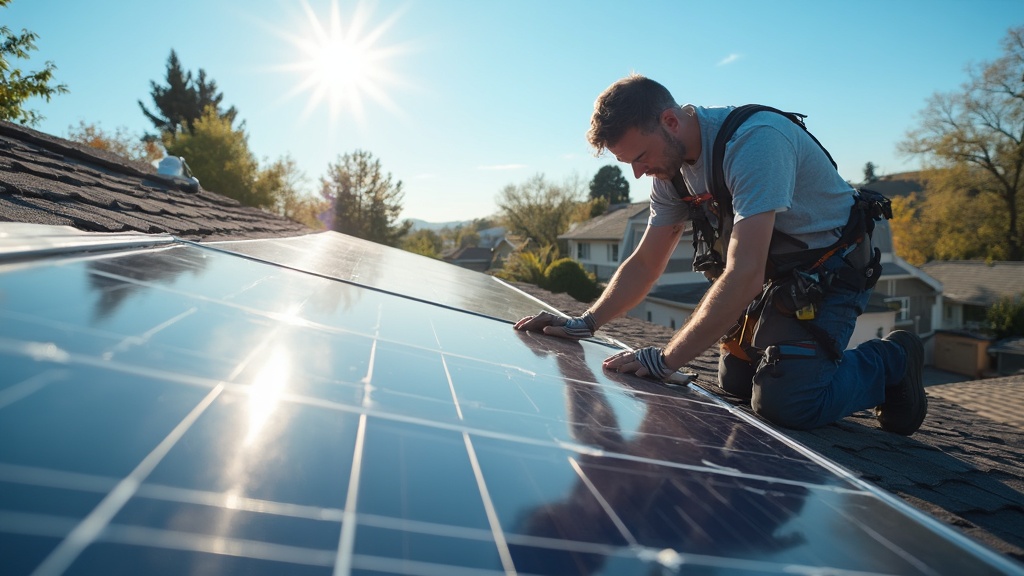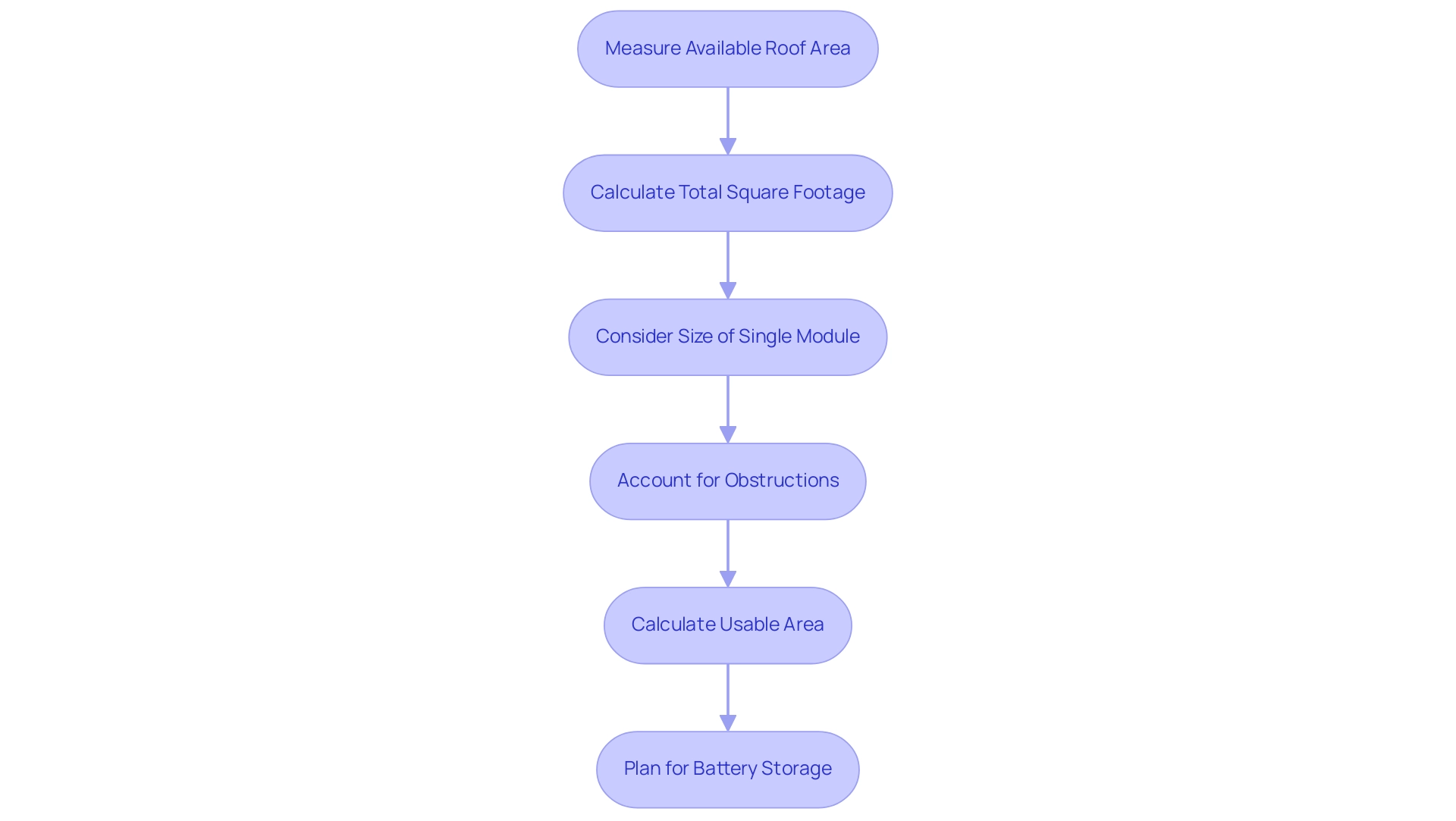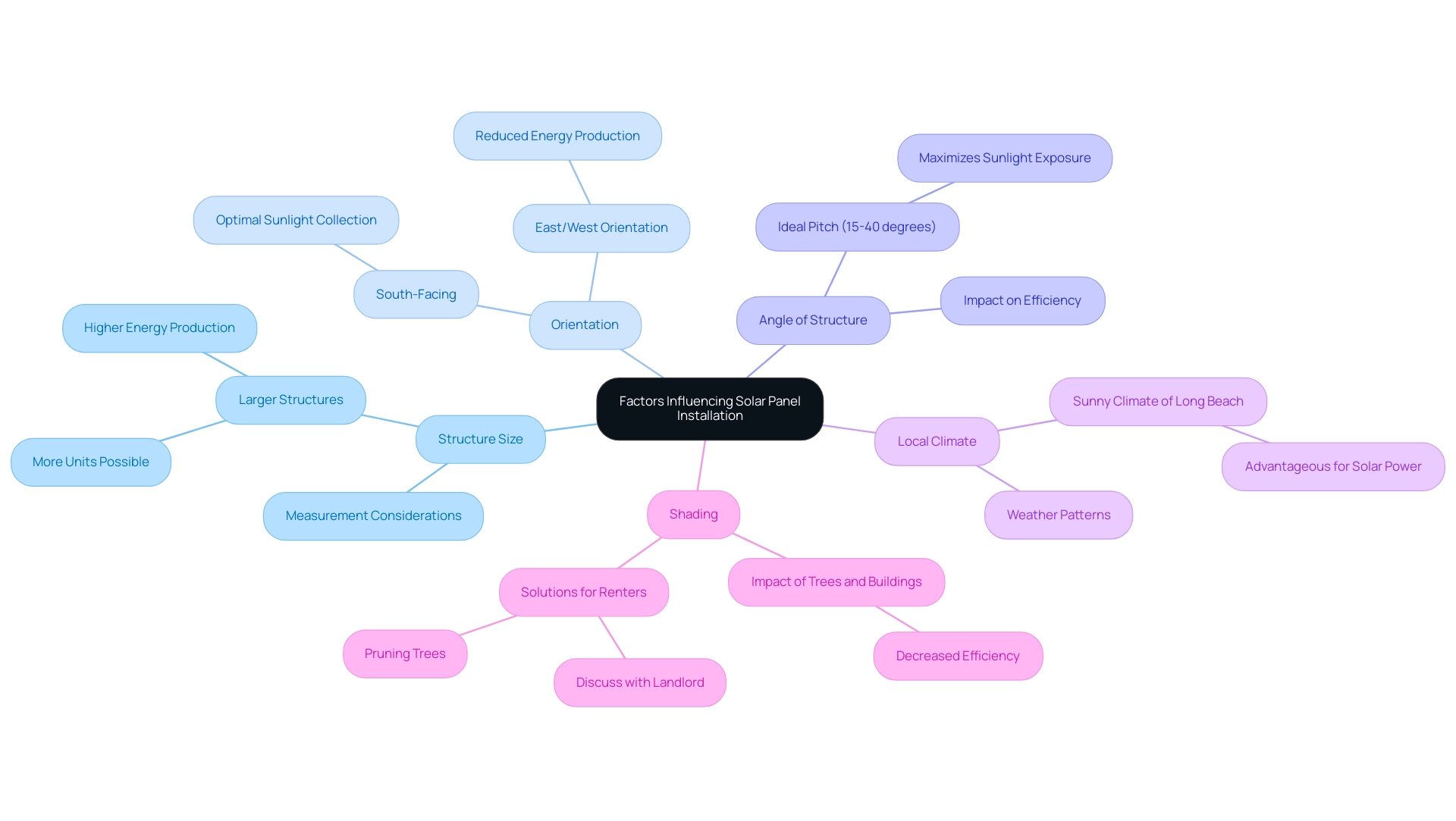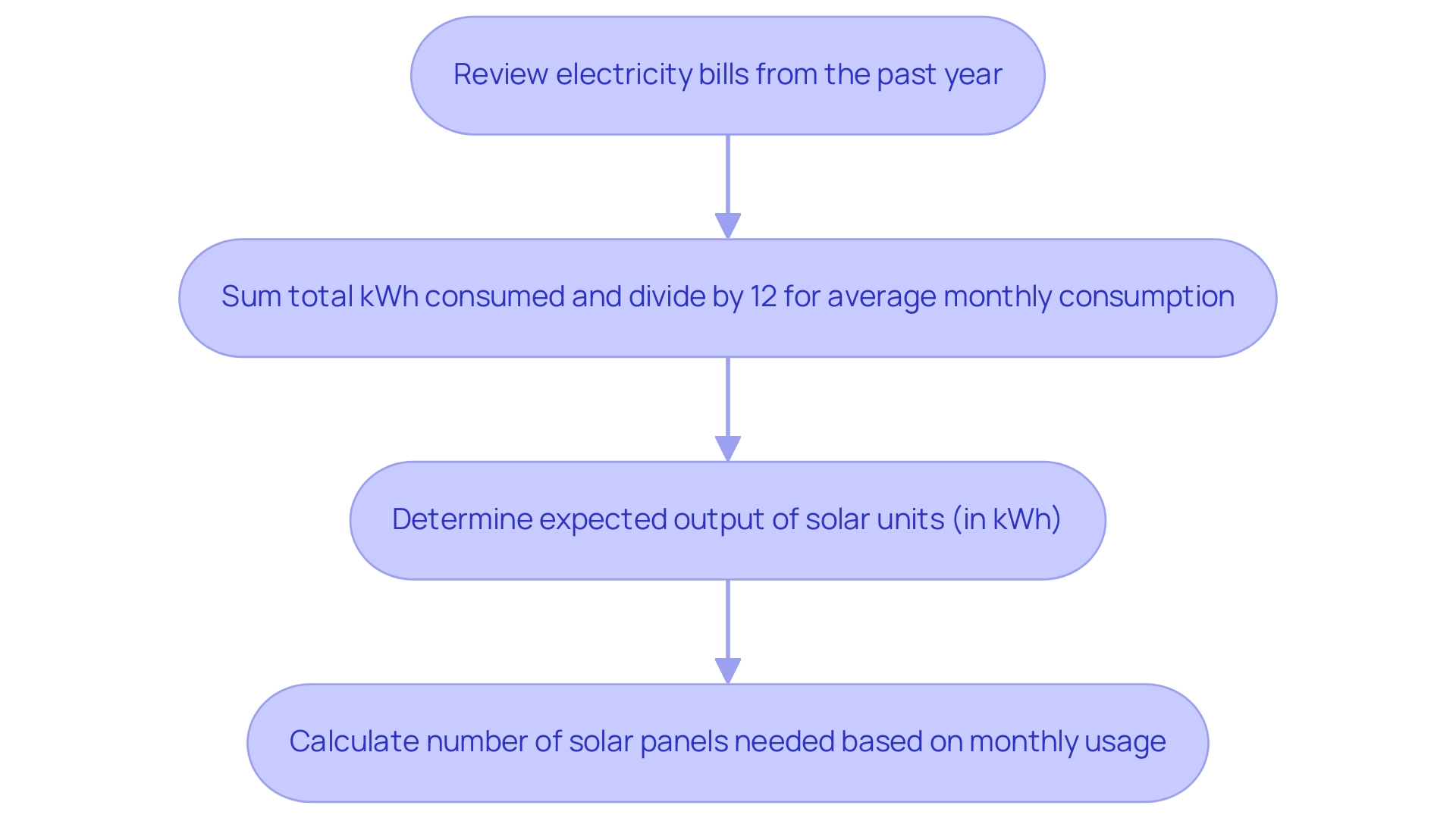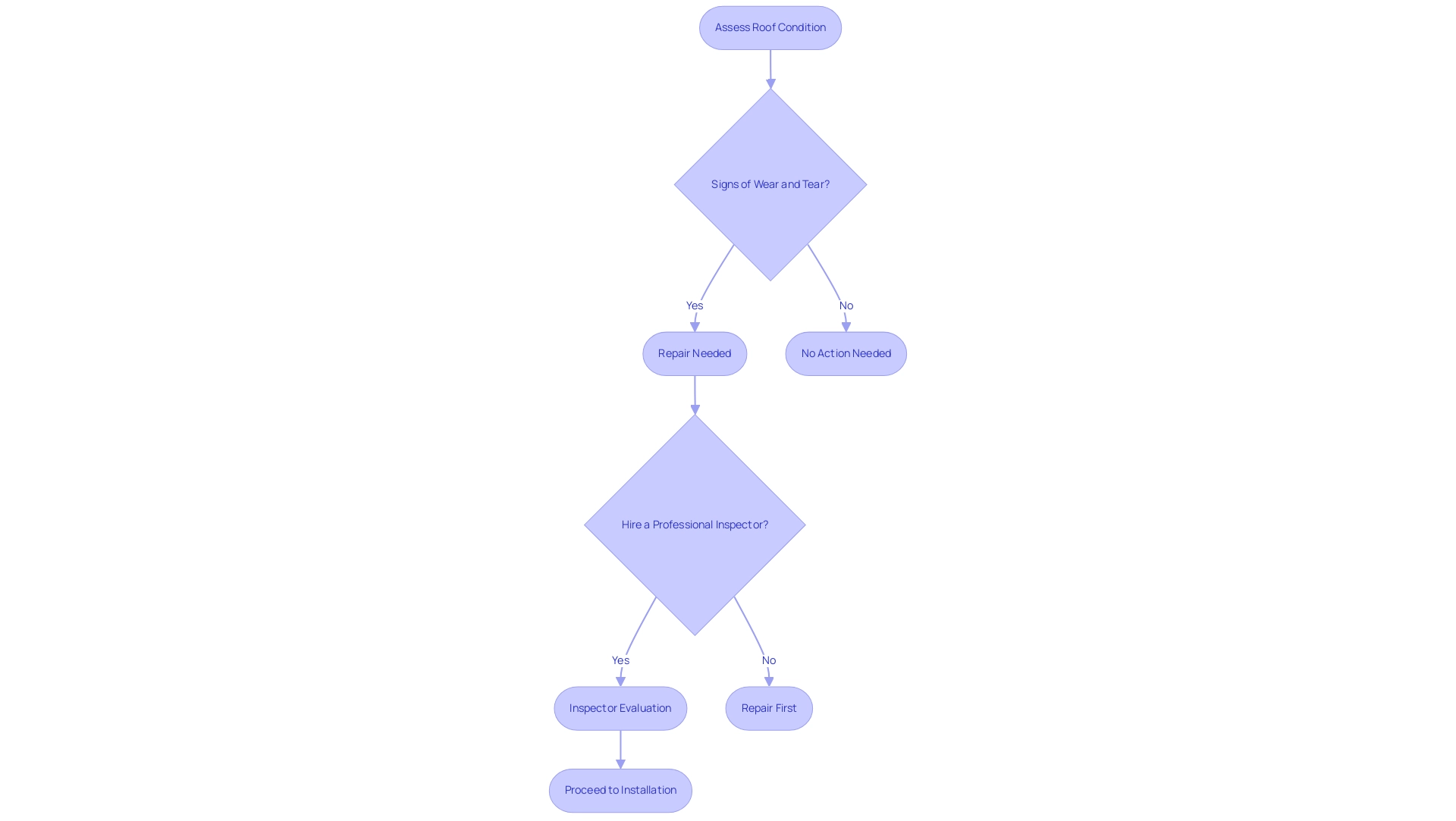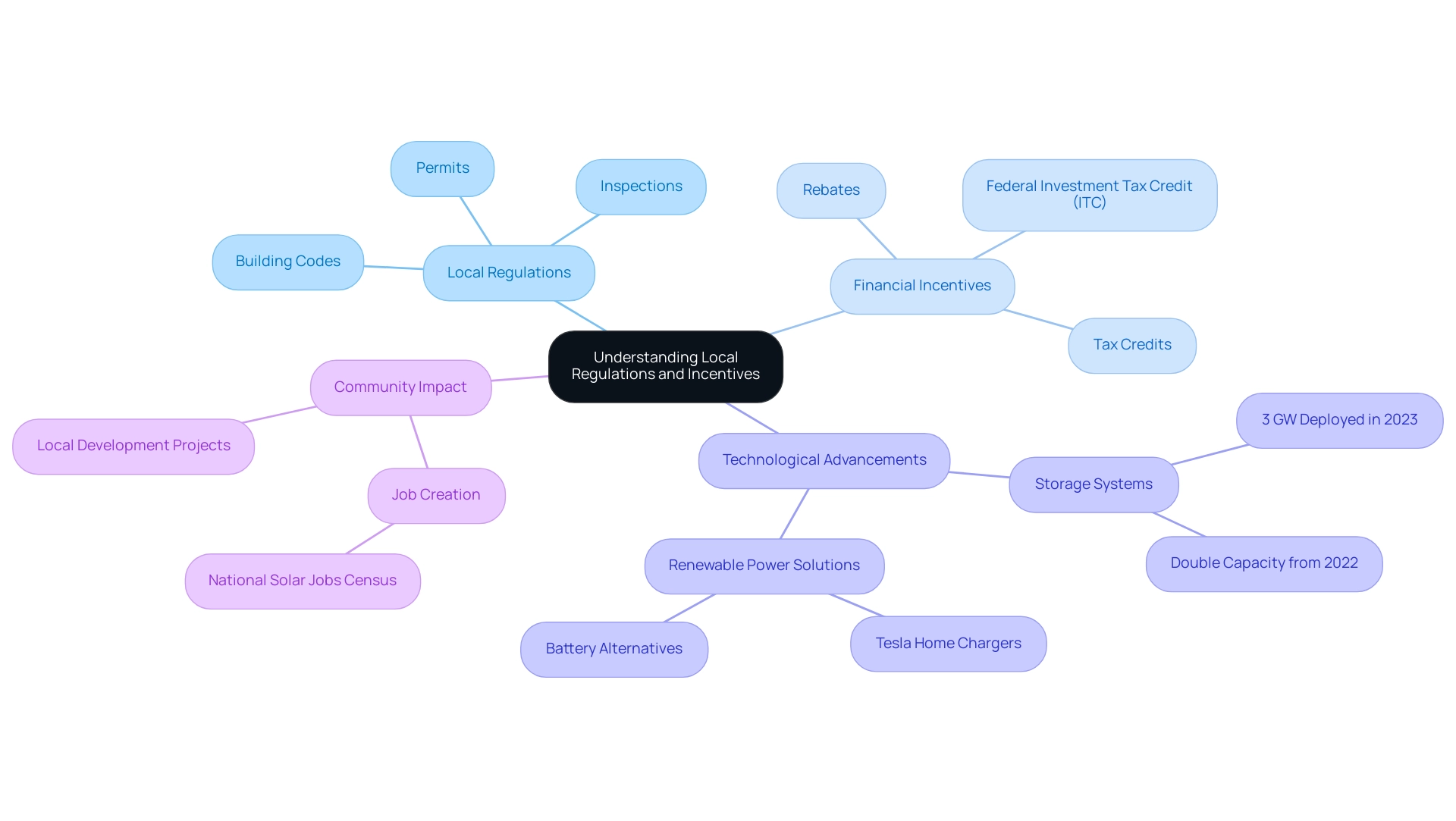Introduction
As homeowners increasingly turn to renewable energy solutions, understanding how to maximize solar panel installations becomes crucial. For those in Long Beach, this journey begins with assessing the unique characteristics of their roofs—size, orientation, and condition—all of which play a significant role in harnessing the sun’s power.
With a sunny climate that favors solar energy, it’s an opportune time to explore how to best utilize available roof space and navigate local regulations and incentives. This article will guide readers through the essential steps:
- Calculating energy needs
- Evaluating roof integrity
Ensuring that every homeowner can make informed decisions that not only enhance their energy efficiency but also contribute to a sustainable future.
Determining Your Roof’s Solar Panel Capacity
To determine how much solar can I fit on my roof, start by measuring your available roof area. Utilize a measuring tape to determine the length and width of the space you’re contemplating for your installations, and multiply these two measurements to obtain your total square footage. Most residential photovoltaic systems occupy around 17.6 square feet, measuring roughly 65 inches by 39 inches, and generally possess efficiency ratings varying from 15% to 22%.
After calculating your total surface area, divide it by the size of a single module to determine how much solar can I fit on my roof. For instance, if your ceiling provides 300 square feet of usable area, you might feasibly set up approximately 17 modules (300 ÷ 17.6).
Be cautious of obstructions such as chimneys, vents, or skylights, as these can restrict the space available for energy installations. By subtracting the space occupied by these obstacles from your total square footage, you’ll gain a clearer understanding of how much solar can I fit on my roof. This thoughtful planning not only optimizes your energy capacity but also enhances your investment in renewable resources, allowing you to determine how much solar can I fit on my roof.
As the share of homeowners installing panels has increased from 4% in 2016 to 6% in 2019, as reported by the Pew Research Center, maximizing your energy capacity at home is becoming increasingly important. Considering that photovoltaic power represented only 3% of all utility-scale electricity in 2021, now is the ideal moment to utilize your upper space. Moreover, with the anticipated decline in the residential energy market by 12% in 2024, it’s essential to understand how much solar can I fit on my roof.
Think about combining your photovoltaic system with effective battery storage solutions, like lithium-ion batteries, recognized for their high power density and durability. This trend is expected to increase substantially in the upcoming years, further improving the efficiency and reliability of your renewable power system.
Key Factors Influencing Solar Panel Installation
When contemplating solar system installation on your structure, particularly as a Long Beach tenant, several important elements contribute significantly to optimizing your power generation:
-
Structure Size: A bigger structure can accommodate more units, resulting in higher energy production. It’s essential to measure your structure accurately and think about the best layout for optimal panel placement.
For renters, discussing options with your landlord about potential installations can be beneficial.
-
Orientation: The direction your structure faces is crucial. South-oriented structures typically gather the most sunlight during the day, rendering them perfect for solar power.
If your structure is oriented east or west, it can still function effectively; however, your energy production may not achieve its maximum potential compared to a south-facing arrangement. Understanding this can assist you in promoting a more solar-friendly structure layout.
-
Angle of the Structure: The pitch of your building affects sunlight exposure.
A roof angle between 15 and 40 degrees is regarded as ideal for sunlight collection, ensuring your units receive the maximum amount of light. Understanding this can help renters present a strong case for installations that maximize efficiency.
-
Local Climate: The amount of sunlight your location receives each year significantly impacts panel efficiency.
Long Beach enjoys a sunny climate, which is advantageous for solar power generation. This highlights the importance of evaluating local weather patterns and how they benefit your energy production.
-
Shading: Be mindful of any trees, buildings, or structures that might cast shadows on your roof.
Such shading can significantly decrease your photovoltaic systems’ efficiency. Tenants might wish to talk about pruning excessive trees or modifying panel arrangements with their property owners to guarantee maximum sunlight access.
Alongside these aspects, think about particular technologies that can improve your power solutions. For example, incorporating Tesla home chargers and battery options can enhance your sunlight utilization, offering effective power storage and electric vehicle charging functionalities.
Moreover, the economic and ecological advantages of renewable resources are considerable. Solar installations can lead to reduced electricity bills, increased property value, and a lower carbon footprint, making them an attractive option for eco-conscious renters. Recent utility-scale photovoltaic prices ranging from $16/MWh to $35/MWh make this form of power a competitively viable option for homeowners looking to invest in renewable solutions.
Government programs and incentives can also aid Long Beach renters in accessing eco-friendly power alternatives without high upfront costs. Learning and development initiatives are crucial, as highlighted by the International Renewable Energy Agency (IRENA), to guarantee that homeowners make knowledgeable choices concerning panel installations.
By considering these aspects, you can make a well-informed choice about the quantity of panels your roof can accommodate and their potential power output. Remember, the goal is to harness the sun’s power effectively, making your home more sustainable and efficient!
Calculating Your Energy Needs
Determining your power requirements is the initial step toward optimizing the effectiveness of your rooftop photovoltaic system, particularly for Long Beach tenants seeking to utilize sustainable power. Start by examining your electricity bills from the past year. Take note of your total kilowatt-hours (kWh) consumed each month.
Once you collect these figures, sum them and divide by 12 to determine your average monthly consumption.
For instance, if your total annual usage is 12,000 kWh, that translates to an average monthly consumption of 1,000 kWh. This number is crucial for determining how much solar can I fit on my roof to meet your energy demands.
Next, let’s discuss the production capabilities of solar units. Each module typically generates between 250 to 400 watts per hour, influenced by factors such as sunlight exposure and module efficiency. To determine how much solar can I fit on my roof, take your average monthly usage (in kWh) and divide it by the expected output of one unit (also converted to kWh).
To find out how much solar can I fit on my roof, you would need approximately 33 panels, assuming each panel generates about 1 kWh daily to meet a monthly usage of 1,000 kWh. This calculation is straightforward: 1,000 kWh divided by 30 days provides you with roughly 33 panels.
It’s also important to acknowledge that residential electricity consumption in the U.S. has surged from 0.1 trillion kWh in 1950 to 1.5 trillion kWh in 2022, reflecting significant growth in usage over the decades. Of the 102.8 million households with cooling equipment, 76.1 million have central A/C, with many of those units being over a decade old. This emphasizes the essential requirement for power efficiency, especially in older systems that might not function ideally.
As Long Beach tenants, you have distinctive chances to access photovoltaic solutions, including government initiatives that can assist in reducing installation expenses. Furthermore, incorporating heating systems—both active and passive solutions—can improve efficiency and support long-term sustainability. With options like Tesla home chargers available, you can further optimize your energy consumption.
Embracing these calculations empowers you to make informed decisions, ultimately contributing to a sustainable future for your home and community.
Evaluating Roof Condition and Structural Integrity
Before entering the thrilling realm of renewable energy installation, it’s crucial to consider how much solar can I fit on my roof carefully. Start by checking for signs of wear and tear—look for missing shingles, leaks, or any sagging areas that might raise a red flag. If your structure is showing its age or is in poor condition, addressing those issues with repairs or even a replacement is a smart move before going solar.
Feeling unsure about your structure’s integrity? Hiring a professional inspector can be a game-changer. They will evaluate how much solar can I fit on my roof to see if your structure can support the additional load of photovoltaic units and identify any needed repairs.
Keep in mind, most residential coverings have a lifespan of around 20 to 30 years, so if your covering is nearing that age, investing in a new one could save you the trouble of removing installations for future repairs.
Interestingly, while many homeowners may not be aware, 16% have resided in their houses for less than five years, which may result in undervaluing the significance of covering evaluations. For newer homeowners, understanding the potential issues is crucial for long-term sustainability. By ensuring your covering is in excellent condition, you can improve the performance of your photovoltaic system and find out how much solar can I fit on my roof, which will help you benefit from considerable reductions on your utility bills.
Photovoltaic panels function by transforming sunlight into electricity, which can subsequently power your residence or recharge storage systems, enabling you to utilize that power when the sun isn’t shining. This functionality is vital for maximizing your energy investment. As Geoff Williams aptly put it,
It isn’t your imagination.
You probably have it tougher than your parents.
This sentiment resonates with many eco-conscious homeowners facing the challenges of maintaining their properties. Making certain your roof is prepared for installation not only safeguards your investment but also improves your home’s energy storage options and aids in creating a more sustainable future.
It’s all about making smart choices for your home and your wallet! To learn more about our energy solutions and roofing services, feel free to reach out.
Understanding Local Regulations and Incentives
Before proceeding with your panel installation, it’s essential for Long Beach renters to familiarize themselves with local regulations and building codes that may affect your project. Each municipality in Southern California has specific requirements, such as permits and inspections, which can vary significantly. A quick conversation with your local government or a reputable energy installation company can clarify what’s needed to comply with these regulations.
Additionally, exploring financial incentives or rebates available in your area is a smart move. Many states, including California, provide tax credits, rebates, or other financial incentives to promote the use of renewable energy. The Federal Investment Tax Credit (ITC) is one such program that can significantly reduce the overall cost of your energy system.
In fact, it’s notable that in 2023, 3 GW of new storage systems were deployed alongside photovoltaic installations—more than double the capacity from 2022—showcasing the exciting advancements in technology.
With the renewable sector aiming for 30% of electricity production from alternative sources by 2030 and plans for 500 GW of additional capacity, now is a favorable moment for environmentally aware homeowners to invest in this technology. This ambitious objective reflects a growing dedication to broadening the role of renewable sources in the U.S. power landscape.
By understanding local regulations and potential financial benefits, you can make informed decisions that not only comply with the law but also save you money on your energy installation. As Eric Paul, Vice President of Partner Development at Nautilus Solar Energy, highlights, “For over ten years, the American renewable sector has been generating new positions and transforming the model for how we acquire our power, as indicated in the National Solar Jobs Census.” Nautilus Energy is dedicated to being a part of this transition by hiring locally and developing community projects that drive economic growth in the communities we serve. This change demonstrates a community-focused strategy for electricity that advantages everyone, making renewable resources an attainable and sustainable option for Long Beach tenants.
Furthermore, it’s crucial to take into account the different renewable power solutions accessible to you, such as Tesla home chargers and battery alternatives, which can improve your autonomy and efficiency. Additionally, regular cleaning services for solar panels are essential to maintain their functionality and maximize energy output, ensuring that your investment continues to perform at its best.
Conclusion
Understanding how to effectively harness solar energy is an empowering step for homeowners looking to make a positive impact on their energy consumption. By determining your roof’s solar panel capacity, calculating energy needs, and evaluating roof conditions, a clearer picture emerges of how to optimize solar installations. Each of these steps ensures that homeowners can make informed decisions tailored to their unique situations, ultimately leading to enhanced energy efficiency and sustainability.
Additionally, recognizing local regulations and available incentives can significantly ease the transition to solar energy. With the right information and planning, the journey toward a solar-powered home becomes not only feasible but also economically beneficial. As the solar industry continues to grow, embracing these renewable solutions contributes to a larger movement towards sustainable living.
In conclusion, maximizing solar panel installations is about more than just reducing electricity bills; it’s about fostering a greener future for the community. By taking proactive steps and leveraging available resources, homeowners can play a crucial role in the shift to renewable energy, ensuring their homes are not just energy-efficient but also part of a collective effort towards sustainability.


